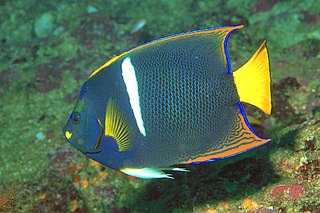 W
WHolacanthus passer is a large marine angelfish of the family Pomacanthidae. Its large size and bright colors make it a popular aquarium fish, even though it can be difficult to keep.
 W
WThe bluntspine blenny is a species of chaenopsid blenny found in coral reefs from Costa Rica to Ecuador, in the eastern central Pacific ocean. It can reach a maximum length of 5.5 centimetres (2.2 in) TL. This species feeds primarily on zooplankton.
 W
WHancock's blenny is a species of chaenopsid blenny found in coral reefs around Costa Rica and Panama, in the eastern central Pacific ocean. and can reach a maximum length of 4.5 cm (1.8 in) TL. This species feeds primarily on zooplankton. The specific name honours the leader of the expedition on which the type was collected, the oil magnate and philanthropist Captain George Allan Hancock (1875-1965).
 W
WThe blue-footed booby is a marine bird native to subtropical and tropical regions of the eastern Pacific Ocean. It is one of six species of the genus Sula – known as boobies. It is easily recognizable by its distinctive bright blue feet, which is a sexually selected trait. Males display their feet in an elaborate mating ritual by lifting them up and down while strutting before the female. The female is slightly larger than the male and can measure up to 90 cm (35 in) long with a wingspan up to 1.5 m (5 ft).
 W
WThe blacknosed butterflyfish or barberfish, is a species of fish in the family Chaetodontidae, the butterfly fishes. It is found in the East Pacific, specifically around the Galápagos Islands and in the Sea of Cortez, and it sometimes acts as a cleaner fish. It is the only member of the genus Johnrandallia, named after the ichthyologist John E. Randall, but in the past it was commonly placed in Chaetodon.
 W
WThe cocinero, also known as the barred jack and striped jack, is a species of small marine fish classified in the jack family, Carangidae. The cocinero is distributed through the tropical eastern Pacific Ocean, ranging along the west American coastline from Baja California in the north to Peru in the south. It is a pelagic species, inhabiting the upper water column in both coastal and offshore oceanic waters, occasionally making its way into estuaries. The species may be identified by its colouration, having 8 or 9 incomplete dark vertical stripes on its sides, with scute and gill raker counts also diagnostic. It is small compared to most other species of Caranx, reaching a length of 37 cm in total. The cocinero is a predatory fish, taking small fishes, crustaceans, and various benthic invertebrates in shallower waters. Little is known of the species' reproductive habits. The cocinero is of moderate importance to fisheries along the west coast of South America, and the species has been used in aquaculture trials. It is taken by various netting methods and by spear, and is sold fresh, dried, and salted at market.
 W
WThe giant damselfish inhabit rocky reefs, below the surf zone at depths of 1–25 m. They feed mainly on low-profile, attached algae. They defend both feeding and reproductive territories by driving off other fishes and divers who come too close. They are oviparous, and form distinct pairings during breeding. The eggs are demersal and adhere to the substrate. Males guard and aerate the eggs.
 W
WDoriprismatica sedna is a species of colorful sea slug, a dorid nudibranch, a marine gastropod mollusk in the family Chromodorididae.
 W
WElacatinus puncticulatus is a species of goby from the eastern central Pacific Ocean where it is found on reefs from the Gulf of California to Ecuador. This species occurs at depths of from 2 to 6 m, usually in association with the sea urchin Eucidaris thouarsii. It grows to a standard length of 4.4 cm (1.7 in). It occasionally is found in the aquarium trade.
 W
WThe giant hawkfish, Cirrhitus rivulatus is a species of hawkfish. It is a marine fish and the largest of the hawkfish family with maximum size of 60 cm (24 in) in total length. It is known for its social behavior towards scuba divers and its uncanny ability to perch on its pectoral fins. This particular species can be found mainly along the Gulf of California, reaching as far as northern Colombia and the Galapagos Islands. It is a predator, mostly feeding on other small fish and crustaceans.
 W
WGrapsus grapsus is one of the most common crabs along the western coast of the Americas. It is known variously as the "red rock crab", "abuete negro", and, along with crabs such as Percnon gibbesi, "Sally Lightfoot crab".
 W
WThe broomtail grouper or mangrove grouper is a species of ray-finned fish from the family Serranidae which is found in the eastern Pacific along the western coast of the Americas from California to Peru.
 W
WThe southern banded guitarfish, also known as the witch guitarfish, is a species of fish in the Rhinobatidae family found at reefs and other habitats from shallow water to a depth of 90 m (300 ft) in the tropical East Pacific. It ranges from Mazatlan, Mexico, to Colombia, but it likely also occurs off Ecuador and Peru. It is closely related to the more northernly distributed banded guitarfish.
 W
WThe scalloped bonnethead is a rare, little-known species of hammerhead shark, and part of the family Sphyrnidae. Its other common names include the mallethead shark and the crown shark. It is found in tropical and subtropical waters in the eastern Pacific Ocean, from Mexico to Peru, and possibly as far north as the Gulf of California. It frequents inshore habitats over soft bottoms to a depth of 100 m, and also enters mangroves and estuaries.
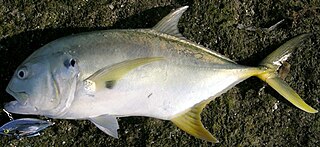 W
WThe Pacific crevalle jack is a species of large marine fish classified in the jack family Carangidae. The species is distributed through the tropical waters of the eastern Pacific Ocean from California in the north to Peru in the south, including several offshore islands. The species is best identified by its deep body and mostly unscaled breast, as well as other more detailed anatomical features. The species is known to grow to a maximum length of 101 cm and a weight of 19.7 kg. Disagreement on the status of the species has been significant in the scientific literature, with many claiming it to be conspecific with or subspecific to the Atlantic Caranx hippos. The most recent review of the crevalle jacks strongly concluded it to be a separate species based on the development of hyperostosis and fin colouring. It is predominantly a schooling inshore species, inhabiting sandy and rocky substrates, although larger individuals are occasionally found living pelagically to depths of 350 m. The Pacific crevalle jack is a fast-swimming predator, taking a variety of fish, crustaceans, and other small invertebrates. Spawning is thought to occur year-round, although peaks occur during November and May. The Pacific crevalle jack is an important species to commercial fisheries, with data available from Colima in Mexico indicating it accounts for up to 15% of the entire yearly catch. Pacific crevalle jack are highly rated gamefish, taken by both bait and a variety of lures, but are considered relatively poor quality food.
 W
WThe green jack, also known as the horse jack, is an abundant species of coastal marine fish in the jack family Carangidae. The species is distributed in the eastern Pacific Ocean along the American coastline from Santa Cruz Island off California in the north to Peru in the south, as well as a number of islands including the Galapagos and recently, Hawaii. The green jack is distinguished from other similar carangid species by a number of features including gill raker and lateral line scale counts, and the presence of an adipose eyelid. It is a moderately large species, growing to at least 55 cm in length and 2.81 kg, although unconfirmed reports suggest a much larger maximum size. It lives in a wide range of continental shelf environments including estuaries, bays, reefs and offshore seamounts, living both pelagically and demersally. The green jack is a predatory species, preying on a variety of fish, crustaceans and cephalopods, as well as zooplankton. Most fish are sexually mature by the time they attain 38 cm, with spawning occurring between May and October. The species is of high importance to fisheries throughout its range, caught by pelagic trawls, a variety of netting methods and hook and line. The green jack is also of interest to anglers, taken by bait and lures, although is considered to only be fair in eating quality.
 W
WThe threadfin jack or thread pompano is a species of coastal marine fish in the jack family Carangidae. The species inhabits the tropical waters of the eastern Pacific Ocean from Baja California in the north to Ecuador and the Galapagos Islands in the south. It is a moderately large fish, growing to 60 cm (24 in) and may be recognized by its filamentous dorsal and anal fin lobes. The threadfin jack inhabits both deeper coastal waters and inshore environments, including reefs and estuaries, where it preys on minute benthic and pelagic organisms, including small fishes and crustaceans. Very little is known about the ecology and reproductive cycle in the species. The threadfin jack is of importance to fisheries throughout its distribution, caught by hook-and-line and net methods and marketed fresh and salted, and is considered a very good table fish. The species was named Carangoides dorsalis by Theodore Gill 20 years before the name Caranx otrynter was introduced, but confusion with Vomer dorsalis led to the proposal of the new name to separate the two species.
 W
WKing-of-the-salmon, Trachipterus altivelis, is a species of ribbonfish in the family Trachipteridae. Its common name comes from the legends of the Makah people west of the Strait of Juan de Fuca, which hold that this fish leads the salmon annually to their spawning grounds. Catching or eating king-of-the-salmon was forbidden, as it was feared killing one would stop the salmon run. This myth is reflected by a former specific epithet used for this fish, rex-salmonorum, rex being Latin for "king". The king-of-the-salmon is found in the eastern Pacific Ocean from Alaska to Chile. It is usually found in the open ocean to a depth of 900 meters, though adults sometimes feed on the sea bottom.
 W
WAbudefduf troschelii, the Pacific sergeant major or Panama sergeant major, is a species of damselfish belonging to the family Pomacentridae that can be identified by their pronounced black stripes on the lateral sides of the fish. Its specific name honors the zoologist Franz Hermann Troschel (1810-1882). It is native to the neritic pelagic zone of the shallow water coral reefs in the Eastern Pacific Ocean and they are an omnivorous species feeding on plankton and algae attached to their coral habitat. Abudefduf troschelii is a sister-species of A. saxatilis but have diverged from each other since the uplift of the isthmus of Panama, separated by the rise of the Panama land bridge 3.1 to 3.5 million years ago. Males, like in many other marine species, take care of and defend newborn A. troschelii after they have been hatched by eggs from the female. There are currently no major threats to the species and there is no indication of a current decline in its population size. The IUCN Red List lists this damselfish as being of “least concern”.
 W
WOccidentarius platypogon, commonly known as the combinate sea-catfish, is a species of sea catfish found in marine and brackish waters along the Pacific coast from Mexico to Peru. It is the only member of its genus. It is a very abundant fish of the continental shelf and is fished for human consumption. It grows to a length of 45 cm.
 W
WThe Pacific chupare or Pacific whiptail stingray, Styracura pacifica, is a species of stingray in the family Potamotrygonidae. It has been reported off the Pacific coast of Central America from Oaxaca, Mexico to Costa Rica, and also around the Galapagos Islands. It is usually found in shallow water on soft silty or muddy flats; it is unknown whether this species is tolerant of low salinity like the related chupare stingray. Leonard Compagno doubted the taxonomic validity of this species in his 1999 Checklist of Living Elasmobranchs.
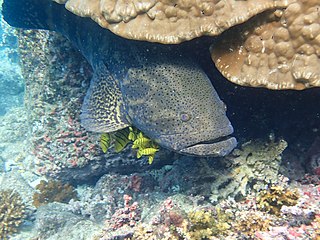 W
WThe Pacific goliath grouper, also known as the Pacific itajara grouper, is a species of marine ray-finned fish, a grouper from the subfamily Epinephelinae which is part of the family Serranidae, which also includes the anthias and sea basses. It found in the eastern Pacific Ocean where it is associated with reefs. It is related to the Atlantic goliath grouper.
 W
WThe Pacific white skate is a species of skate in the family Arhynchobatidae. It is one of the deepest-living of all skates, occurring at a depth of 800 to 2,938 m on the continental slope. It is native to the southeast Pacific Ocean from the Galapagos Islands to off Waldport, Oregon; an egg case and embryo has been collected from the Farallon Islands off San Francisco. Reports of it from the Sea of Okhotsk may represent a different species. Its species name, spinosissima, comes from the Latin spinosus meaning "thorny", referring to its covering of dermal denticles.
 W
WThe panamic green moray eel is a large moray eel in the Pacific. Common names also include chestnut moray eel.
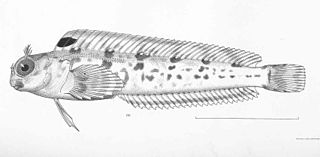 W
WParahypsos piersoni is a species of combtooth blenny found in coral reefs in the eastern Pacific ocean, from Costa Rica to Peru. The specific name honours C.J. Pierson, who was a member of the expedition to Panama on which the type was collected.
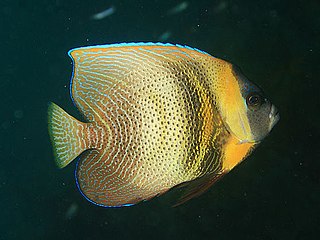 W
WPomacanthus zonipectus, the Cortez angelfish, is a marine angelfish from the Eastern Pacific. It occasionally makes its way into the aquarium trade. It grows to a size of 46 cm in length.
 W
WArothron meleagris, commonly known as the guineafowl puffer or golden puffer, is a pufferfish from the Indo-Pacific, and Eastern Pacific. It is occasionally harvested for the aquarium trade. It reaches 50 cm in length.
 W
WThe golden cownose ray or Pacific cownose ray is a species of eagle ray, family Myliobatidae. It is found in the East Pacific along the coast of Colombia, Costa Rica, Ecuador, El Salvador, Guatemala, Honduras, Mexico, Nicaragua, Panama, and Peru. Its natural habitats are open seas, shallow seas, subtidal aquatic beds, estuarine waters, intertidal marshes, and coastal saline lagoons. They are often in schools, and sometimes associated with the spotted eagle ray.
 W
WThe giant electric ray or Cortez electric ray is a species of numbfish, family Narcinidae, native to the eastern Pacific Ocean from the Gulf of California to Panama. It is found in shallow water on sandy bottoms and sometimes adjacent to reefs. This species is closely related to the lesser electric ray from the western Atlantic, and may represent the same species. The specific epithet entemedor seems to be the Spanish equivalent of "intimidator".
 W
WThe ocellated electric ray or bullseye electric ray is a species of electric ray in the family Narcinidae, native to the shallow inshore waters of the eastern central Pacific from the Gulf of California to Ecuador. Reaching 25 cm (9.8 in) in length, this species has a rounded pectoral fin disc and pelvic fins with convex margins. Its short and thick tail bears two dorsal fins and terminates in a triangular caudal fin. The ocellated electric ray is named for the distinctive large eyespot on the middle of its disc, consisting of a black or yellow center surrounded by concentric rings. Its dorsal coloration is otherwise highly variable, ranging from plain to ornately patterned on a light to dark brown background. The front part of its disc is darker brown.
 W
WThe scoophead is a little-known species of hammerhead shark, part of the family Sphyrnidae. It inhabits the tropical waters of the western Atlantic Ocean, from Panama to southern Brazil, and in the eastern Pacific Ocean from the Gulf of California to Ecuador, and probably northern Peru, as well. It is found in shallow, inshore habitats.
 W
WSelene brevoortii, the hairfin look down, also known as the airfin lookdown, Mexican lookdown or Pacific lookdown, is a species of carangid fish native to warmer parts of the East Pacific where it is found from southernmost California, United States to northern Peru. This species is generally found close to the coast at depths of less than 50 m (160 ft). They grow to 38 cm (15 in) in fork length. It is of minor importance to local commercial fisheries, but is popular as a gamefish. Its specific name honours the American book collector, numismatist, amateur naturalist and friend of Theodore N. Gills J. Carson Brevoort (1817-1887) for his interest in the fishes of the family Carangidae.
 W
WGinglymostoma unami, also known as the Pacific nurse shark is a nurse sharks of the family Ginglymostomatidae. It is found in southeastern coast of Baja California, Mexico to Costa Rica including Gulf of California. This species differs from Ginglymostoma cirratum between posterior end of the second dorsal fin and the beginning of the caudal lobe, both being shorter; the new species also differs by the position of the insertion of the first dorsal fin with regard to the pelvic fins and in the form and number of keels on the dermal denticles and teeth morphology.
 W
WThe Pacific smalltail shark is a species of requiem shark, in the family Carcharhinidae. It was described in 1898, but later mistakenly merged with Carcharhinus porosus. The mistake was corrected in 2011.
 W
WThe whitenose shark is a species of shark of the family Carcharhinidae. The only member of the genus Nasolamia, it is found in the tropical waters of the eastern Pacific Ocean between latitudes 31° N and 18° S, between depths of 15 to 200 m. It can grow up to a length of 1.5 m. The whitenose shark is viviparous, with 5 young in a litter, and a birth size around 53 cm.
 W
WThe sharptooth smooth-hound is a houndshark of the family Triakidae. It is found on the continental shelves of the tropical eastern Pacific from southern Mexico to Peru between latitudes 20°N and 5°S. Its length is up to 64 cm.
 W
WThe sicklefin smooth-hound is a houndshark of the family Triakidae. Even some species look similar to Carcharhinus family, mustelus second dorsal fin is much bigger. It is found on the continental shelves of the eastern Pacific, between latitudes 33° N and 7° N. The difference between sharptooth smooth-hound and mustelus lunulatus, is that the lunulatus second dorsal fin origin far in advance of the anal fin. It can reach a length of up to 1.7 m. The reproduction of this shark is ovoviviparous.
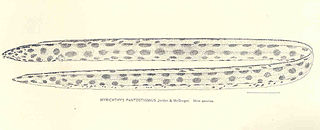 W
WThe Clarion snake eel is an eel in the family Ophichthidae. It was described by David Starr Jordan and Ernest Alexander McGregor in 1898. It is a tropical, marine eel which is known from Mexico, in the eastern central Pacific Ocean. It inhabits shallow waters - at a maximum depth of 20 metres - and is found around rocks and sand. Males can reach a maximum total length of 49.4 centimetres.
 W
WThe spotted snake-eel, also known as the tiger snake eel or the spotted tiger snake eel, is an eel in the family Ophichthidae. It was described by Charles Frédéric Girard in 1859. It is a marine, tropical eel which is known from the eastern central and southeastern Pacific Ocean, including Chile, Costa Rica, Colombia, El Salvador, Ecuador, Mexico, Guatemala, Nicaragua, Panama, Honduras, and Peru. It dwells at a depth range of 0 to 60 metres, and inhabits benthic sediments of mud and sand. Males can reach a maximum total length of 74 centimetres (29 in), but more commonly reach a TL of 60 centimetres (24 in).
 W
WThe Mexican barred snapper is a species of snapper native to the Pacific coast of Central and northern South America from Mexico to Colombia. They inhabit rocky areas near coral reefs at depths from very shallow waters to around 50 m (160 ft). This species grows to 92 cm (36 in) in total length, though most only reach 50 cm (20 in). The heaviest known example of this species weighed 9.6 kg (21 lb). This species is important to local inhabitants as a food fish and is also sought as a game fish. It can also be found displayed in public aquaria. This species is the only known member of its genus.
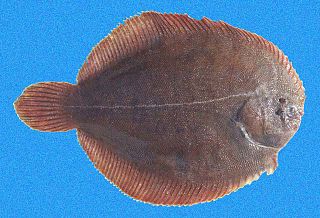 W
WThe brown sole is a sole of the genus Achirus native to the eastern Pacific from central Mexico to northernmost Peru. This demersal species growth up to 23 cm (9.1 in). It is found at depths of 10–40 m on sandy and muddy grounds and may enter fresh waters in estuaries and mangroves. Its diet consists of invertebrates, small fishes, pelagic eggs and larvae.
 W
WThe network sole is a sole of the genus Achirus native to the eastern Pacific from the tip of Baja California and the southeastern Gulf of California to northern Peru. This demersal species growth up to 28 cm (11 in). It is found at depths 5–45 m in coastal lagoons and fresh water. Its diet consists of crustaceans, small fishes, polychaetes, and occasionally detritus.
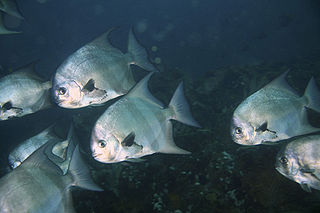 W
WThe Pacific spadefish is a species of fish of the family Ephippidae. It is native to the eastern Pacific, from San Diego, California to Peru, including is the Galápagos Islands where it is known as Chambo.
 W
WThe diamond stingray is a species of stingray in the family Dasyatidae. It is found in the coastal waters of the eastern Pacific Ocean from southern California to northern Chile, and around the Galápagos and Hawaiian Islands. This bottom-dweller generally inhabits sandy or muddy flats near rocky reefs and kelp forests, to a depth of 30 m (98 ft), though off Hawaii it may range considerably deeper. As its common name suggests, this species has an angular, diamond-shaped pectoral fin disc that is plain brown or gray above, with rows of tubercles along the midline and on the "shoulders". The long, whip-like tail has both dorsal and ventral fin folds, which distinguish this ray from the closely similar longtail stingray (D. longa). It typically grows to 1 m (3.3 ft) across.
 W
WThe longtail stingray, is a species of stingray in the family Dasyatidae, found in the eastern Pacific Ocean from Baja California to Colombia. It inhabits sandy habitats down to a depth of 90 m (300 ft). Measuring up to 1.56 m (5.1 ft) across, this species has a rhomboid pectoral fin disc, a lower fin fold on the tail, and numerous dermal denticles along the back and behind the stinging spine. The longtail stingray feeds mainly on bottom-dwelling bony fishes and crustaceans. It is aplacental viviparous, with females giving birth to 1–5 young in late summer. At present, the International Union for Conservation of Nature (IUCN) is unable to assess this species beyond Data Deficient. It is caught for food, likely throughout its range, but specific fishery data is lacking.
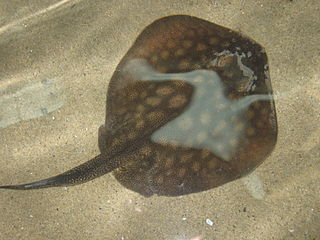 W
WThe round stingray or Haller's round ray and Little round stingray is a species of round ray, family Urotrygonidae, found in the coastal waters of the eastern Pacific Ocean. It is a small, common ray that feeds mostly on benthic invertebrates. On the beaches of southern California, it is responsible for numerous injuries to bathers, who are stung when they accidentally step on the fish. The wound caused by its venomous spine can be painful, but is non-fatal.
 W
WThe gafftopsail pompano is a species of jack in the family Carangidae. It is found in the eastern Pacific.
 W
WThe zebra moray, Gymnomuraena zebra, is a species of marine fish in the family Muraenidae. It is the only member of the genus Gymnomuraena, though it sometimes has been included in Echidna instead.